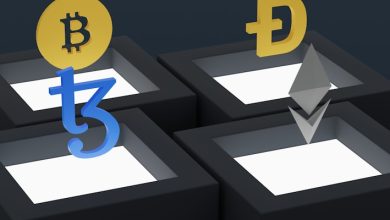The Role of Mining in Cryptocurrency Networks: A Beginner’s Guide

- Understanding the Basics of Cryptocurrency Mining
- How Cryptocurrency Mining Secures Blockchain Networks
- The Process of Generating New Coins through Mining
- Exploring the Different Mining Algorithms Used in Cryptocurrencies
- The Impact of Mining on Transaction Verification in Blockchain
- Tips for Getting Started with Cryptocurrency Mining as a Beginner
Understanding the Basics of Cryptocurrency Mining
Cryptocurrency mining is the process by which new transactions are added to a blockchain and new coins are minted. Miners use powerful computers to solve complex mathematical problems that validate transactions and secure the network. This process requires a significant amount of computational power and energy, leading to the consumption of electricity.
One of the key concepts in cryptocurrency mining is the proof-of-work consensus mechanism, which requires miners to show proof that they have performed a certain amount of computational work in order to add a new block to the blockchain. This proof is verified by other nodes on the network before the block is added, ensuring the security and integrity of the blockchain.
Miners are rewarded for their efforts with newly minted coins and transaction fees. The more computational power a miner contributes to the network, the higher their chances of being the first to solve the mathematical problem and add a new block to the blockchain. However, as more miners join the network, the difficulty of the problems increases, requiring even more computational power to mine effectively.
It’s important to note that not all cryptocurrencies use proof-of-work for mining. Some cryptocurrencies, such as Ethereum, are transitioning to a proof-of-stake consensus mechanism, which requires validators to hold a certain amount of the cryptocurrency in order to mine new blocks. This shift is aimed at reducing energy consumption and making mining more accessible to a wider audience.
How Cryptocurrency Mining Secures Blockchain Networks
Cryptocurrency mining plays a crucial role in securing blockchain networks by validating transactions and adding them to the public ledger. Miners use powerful computers to solve complex mathematical puzzles, which helps confirm transactions and prevent double-spending. This process ensures the integrity and security of the blockchain network.
Miners compete with each other to solve these puzzles and add a new block to the blockchain. The first miner to solve the puzzle is rewarded with newly minted coins and transaction fees. This incentivizes miners to continue participating in the network and securing it against malicious attacks.
By dedicating computational power to mining, individuals and mining pools contribute to the decentralized nature of blockchain networks. This distributed network of miners helps prevent any single entity from gaining control over the network, thereby maintaining its security and trustworthiness.
The Process of Generating New Coins through Mining
One of the key aspects of participating in a cryptocurrency network is the process of generating new coins through mining. Mining involves using computer hardware to solve complex mathematical equations, which in turn validates transactions on the network. This process is essential for maintaining the security and integrity of the blockchain.
Mining is a competitive process where miners compete to be the first to solve the mathematical equation and add a new block of transactions to the blockchain. The miner who successfully adds a new block is rewarded with a certain number of newly minted coins, which is how new coins are introduced into circulation.
To participate in mining, individuals or groups need specialized hardware, such as ASIC miners or GPUs, to perform the necessary calculations. Additionally, miners must be connected to the internet to receive the latest transactions and updates to the blockchain.
As the number of miners in a network increases, the difficulty of mining also increases. This is due to the network’s self-adjusting mechanism, which ensures that new blocks are added at a consistent rate. Miners must constantly upgrade their hardware and stay competitive to continue earning rewards.
Overall, mining plays a crucial role in the operation of cryptocurrency networks by securing transactions, adding new coins to circulation, and incentivizing participation in the network. It is a complex process that requires technical expertise, specialized hardware, and a competitive spirit.
Exploring the Different Mining Algorithms Used in Cryptocurrencies
Cryptocurrency networks rely on mining algorithms to validate transactions and secure the network. There are various mining algorithms used in different cryptocurrencies, each with its unique characteristics and requirements.
One of the most common mining algorithms is the Proof of Work (PoW) algorithm, which requires miners to solve complex mathematical puzzles to validate transactions and create new blocks. This algorithm is used in popular cryptocurrencies like Bitcoin and Ethereum.
Another mining algorithm is the Proof of Stake (PoS) algorithm, where validators are chosen to create new blocks based on the number of coins they hold. This algorithm is considered more energy-efficient compared to PoW but has its own set of challenges.
Other mining algorithms include Proof of Capacity (PoC), which requires miners to prove they have a certain amount of storage space to mine new blocks, and Proof of Authority (PoA), where validators are chosen based on their reputation and identity.
Overall, understanding the different mining algorithms used in cryptocurrencies is crucial for miners and investors to make informed decisions and navigate the ever-evolving landscape of digital currencies. By staying informed about these algorithms, individuals can better understand how cryptocurrencies operate and potentially benefit from participating in mining activities.
The Impact of Mining on Transaction Verification in Blockchain
Mining plays a crucial role in verifying transactions on a blockchain network. When a transaction is initiated, it is grouped with other transactions into a block. Miners compete to solve complex mathematical puzzles to validate the transactions in the block. This process requires a significant amount of computational power, as miners must make numerous calculations to find the correct solution.
Once a miner solves the puzzle, they add the block of transactions to the blockchain. This block is then cryptographically linked to the previous block, forming a chain of blocks. This verification process ensures that transactions are legitimate and cannot be altered once they are added to the blockchain. Without mining, there would be no way to secure the network and prevent double-spending.
However, mining also has its drawbacks. The energy-intensive nature of mining has raised concerns about its environmental impact. Additionally, as more miners join the network, the difficulty of the puzzles increases, leading to higher competition and slower verification times. This scalability issue has prompted developers to explore alternative consensus mechanisms, such as proof of stake.
Tips for Getting Started with Cryptocurrency Mining as a Beginner
When starting with cryptocurrency mining as a newcomer, there are several tips to keep in mind to ensure a smooth and successful experience. Here are some helpful suggestions to get you started on the right track:
- Research different cryptocurrencies to find the best fit for your mining goals.
- Invest in the proper hardware, such as a powerful GPU or ASIC miner, to maximize your mining efficiency.
- Join a mining pool to increase your chances of earning rewards consistently.
- Set up a secure wallet to store your mined coins safely.
- Stay updated on the latest mining trends and technologies to stay competitive in the market.
By following these tips, you can navigate the world of cryptocurrency mining with confidence and start generating profits in no time.



